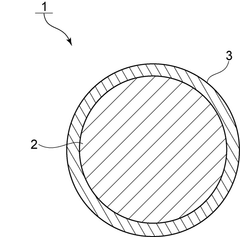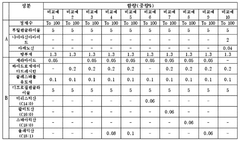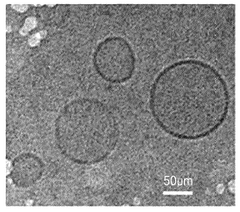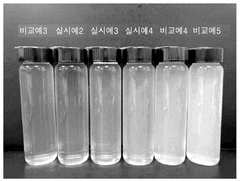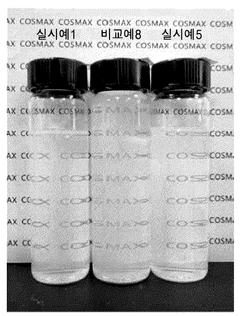How to Boost Skin Absorption with Sodium Alginate Compositions?
JUL 14, 20259 MIN READ
Generate Your Research Report Instantly with AI Agent
Patsnap Eureka helps you evaluate technical feasibility & market potential.
Sodium Alginate Skin Absorption Background
Sodium alginate, a naturally occurring polysaccharide derived from brown seaweed, has gained significant attention in the field of dermatology and cosmetic science for its potential to enhance skin absorption. This versatile compound has been widely used in various industries, including food, pharmaceuticals, and cosmetics, due to its unique properties such as biocompatibility, biodegradability, and non-toxicity.
The interest in sodium alginate for skin absorption stems from its ability to form hydrogels and its potential as a drug delivery system. Historically, the use of sodium alginate in skincare can be traced back to the mid-20th century, but it has seen a resurgence in recent years as researchers explore novel ways to improve the efficacy of topical treatments.
The evolution of sodium alginate in skin absorption technology has been driven by the increasing demand for more effective and targeted delivery of active ingredients through the skin barrier. Traditional topical formulations often face challenges in penetrating the stratum corneum, the outermost layer of the skin, which acts as a protective barrier. Sodium alginate compositions have shown promise in overcoming this barrier and enhancing the absorption of various compounds.
Recent advancements in nanotechnology and polymer science have further expanded the potential applications of sodium alginate in skin absorption. Researchers have been exploring various modifications and combinations of sodium alginate with other materials to create advanced delivery systems, such as nanoparticles, microemulsions, and hydrogel patches.
The growing interest in natural and sustainable ingredients in the cosmetic and pharmaceutical industries has also contributed to the increased focus on sodium alginate. As consumers become more conscious of the ingredients in their skincare products, there is a rising demand for plant-based and eco-friendly alternatives to synthetic compounds.
Understanding the mechanisms by which sodium alginate enhances skin absorption is crucial for developing effective formulations. Current research suggests that sodium alginate may work through multiple pathways, including increasing skin hydration, forming a protective film on the skin surface, and interacting with skin proteins to facilitate the penetration of active ingredients.
As the field continues to evolve, researchers are exploring innovative approaches to optimize sodium alginate compositions for improved skin absorption. These efforts include investigating the effects of molecular weight, degree of crosslinking, and combination with other polymers or penetration enhancers. The goal is to develop tailored formulations that can effectively deliver a wide range of active ingredients, from small molecules to large biomolecules, through the skin barrier.
The interest in sodium alginate for skin absorption stems from its ability to form hydrogels and its potential as a drug delivery system. Historically, the use of sodium alginate in skincare can be traced back to the mid-20th century, but it has seen a resurgence in recent years as researchers explore novel ways to improve the efficacy of topical treatments.
The evolution of sodium alginate in skin absorption technology has been driven by the increasing demand for more effective and targeted delivery of active ingredients through the skin barrier. Traditional topical formulations often face challenges in penetrating the stratum corneum, the outermost layer of the skin, which acts as a protective barrier. Sodium alginate compositions have shown promise in overcoming this barrier and enhancing the absorption of various compounds.
Recent advancements in nanotechnology and polymer science have further expanded the potential applications of sodium alginate in skin absorption. Researchers have been exploring various modifications and combinations of sodium alginate with other materials to create advanced delivery systems, such as nanoparticles, microemulsions, and hydrogel patches.
The growing interest in natural and sustainable ingredients in the cosmetic and pharmaceutical industries has also contributed to the increased focus on sodium alginate. As consumers become more conscious of the ingredients in their skincare products, there is a rising demand for plant-based and eco-friendly alternatives to synthetic compounds.
Understanding the mechanisms by which sodium alginate enhances skin absorption is crucial for developing effective formulations. Current research suggests that sodium alginate may work through multiple pathways, including increasing skin hydration, forming a protective film on the skin surface, and interacting with skin proteins to facilitate the penetration of active ingredients.
As the field continues to evolve, researchers are exploring innovative approaches to optimize sodium alginate compositions for improved skin absorption. These efforts include investigating the effects of molecular weight, degree of crosslinking, and combination with other polymers or penetration enhancers. The goal is to develop tailored formulations that can effectively deliver a wide range of active ingredients, from small molecules to large biomolecules, through the skin barrier.
Market Analysis for Transdermal Drug Delivery
The transdermal drug delivery market has been experiencing significant growth in recent years, driven by the increasing demand for non-invasive drug administration methods and the advantages offered by this delivery system. The global transdermal drug delivery market was valued at approximately $6.5 billion in 2020 and is projected to reach $8.9 billion by 2025, growing at a CAGR of 6.4% during the forecast period.
Several factors contribute to the market's expansion. Firstly, the rising prevalence of chronic diseases, such as cardiovascular disorders, diabetes, and neurological conditions, has increased the need for continuous and controlled drug delivery systems. Transdermal drug delivery offers a solution by providing steady drug release over extended periods, improving patient compliance and therapeutic outcomes.
Additionally, the aging population worldwide has created a substantial market opportunity. Elderly patients often face challenges with oral medication due to dysphagia or reduced gastrointestinal absorption. Transdermal patches offer a convenient alternative, ensuring consistent drug delivery without the need for frequent dosing.
The market is also benefiting from technological advancements in patch design and formulation. Innovations in polymer science and nanotechnology have led to the development of more efficient and patient-friendly transdermal systems. These advancements have expanded the range of drugs that can be delivered transdermally, including larger molecules and biologics.
Geographically, North America dominates the transdermal drug delivery market, followed by Europe. This is attributed to the high healthcare expenditure, advanced healthcare infrastructure, and favorable reimbursement policies in these regions. However, the Asia-Pacific region is expected to witness the highest growth rate in the coming years, driven by improving healthcare access, rising disposable incomes, and increasing awareness about advanced drug delivery systems.
Key players in the transdermal drug delivery market include Johnson & Johnson, Novartis AG, Boehringer Ingelheim, GlaxoSmithKline, and Mylan N.V. These companies are investing heavily in research and development to introduce innovative transdermal products and expand their market share.
Despite the positive outlook, the market faces challenges such as skin irritation and allergic reactions associated with some transdermal patches. Additionally, the limited drug loading capacity of traditional patches and the difficulty in delivering large molecule drugs transdermally pose constraints to market growth. However, ongoing research in areas such as microneedle technology and iontophoresis shows promise in overcoming these limitations, potentially opening up new avenues for market expansion.
Several factors contribute to the market's expansion. Firstly, the rising prevalence of chronic diseases, such as cardiovascular disorders, diabetes, and neurological conditions, has increased the need for continuous and controlled drug delivery systems. Transdermal drug delivery offers a solution by providing steady drug release over extended periods, improving patient compliance and therapeutic outcomes.
Additionally, the aging population worldwide has created a substantial market opportunity. Elderly patients often face challenges with oral medication due to dysphagia or reduced gastrointestinal absorption. Transdermal patches offer a convenient alternative, ensuring consistent drug delivery without the need for frequent dosing.
The market is also benefiting from technological advancements in patch design and formulation. Innovations in polymer science and nanotechnology have led to the development of more efficient and patient-friendly transdermal systems. These advancements have expanded the range of drugs that can be delivered transdermally, including larger molecules and biologics.
Geographically, North America dominates the transdermal drug delivery market, followed by Europe. This is attributed to the high healthcare expenditure, advanced healthcare infrastructure, and favorable reimbursement policies in these regions. However, the Asia-Pacific region is expected to witness the highest growth rate in the coming years, driven by improving healthcare access, rising disposable incomes, and increasing awareness about advanced drug delivery systems.
Key players in the transdermal drug delivery market include Johnson & Johnson, Novartis AG, Boehringer Ingelheim, GlaxoSmithKline, and Mylan N.V. These companies are investing heavily in research and development to introduce innovative transdermal products and expand their market share.
Despite the positive outlook, the market faces challenges such as skin irritation and allergic reactions associated with some transdermal patches. Additionally, the limited drug loading capacity of traditional patches and the difficulty in delivering large molecule drugs transdermally pose constraints to market growth. However, ongoing research in areas such as microneedle technology and iontophoresis shows promise in overcoming these limitations, potentially opening up new avenues for market expansion.
Current Challenges in Skin Penetration Enhancement
Enhancing skin penetration remains a significant challenge in the field of dermatology and cosmetic science. Despite advancements in formulation technologies, the skin's natural barrier function continues to pose obstacles for effective delivery of active ingredients. The stratum corneum, the outermost layer of the epidermis, acts as a formidable barrier, limiting the absorption of many topically applied substances.
One of the primary challenges is the selective permeability of the skin. The lipid-rich intercellular matrix of the stratum corneum restricts the passage of hydrophilic molecules, while also impeding the penetration of large molecular weight compounds. This selectivity often results in suboptimal absorption of active ingredients, reducing the efficacy of many topical formulations.
Another significant hurdle is the variability in skin characteristics among individuals. Factors such as age, hydration levels, and skin conditions can greatly influence the penetration of topical agents. This variability makes it difficult to develop universally effective penetration enhancement strategies, necessitating personalized approaches in some cases.
The stability and compatibility of penetration enhancers with active ingredients present additional challenges. Many conventional penetration enhancers may interact with or degrade the active compounds, potentially reducing their effectiveness or altering their intended functions. This necessitates careful formulation considerations to ensure the integrity and efficacy of the final product.
Safety concerns also play a crucial role in the development of skin penetration enhancement technologies. While increasing skin permeability is desirable for improved absorption, it may also potentially increase the risk of irritation or systemic absorption of unwanted substances. Striking a balance between enhanced penetration and maintaining skin barrier integrity is a delicate task that requires extensive research and testing.
The development of novel, safe, and effective penetration enhancers remains an ongoing challenge. Traditional methods often rely on chemical enhancers that may cause skin irritation or damage with prolonged use. There is a growing demand for natural, biocompatible enhancers that can improve skin penetration without compromising skin health or causing adverse effects.
In the context of sodium alginate compositions, specific challenges arise due to the hydrophilic nature and high molecular weight of alginate polymers. While sodium alginate offers excellent biocompatibility and film-forming properties, its large molecular size typically limits its direct penetration into the skin. Developing strategies to leverage the beneficial properties of sodium alginate while overcoming its penetration limitations is a key area of focus for researchers in this field.
One of the primary challenges is the selective permeability of the skin. The lipid-rich intercellular matrix of the stratum corneum restricts the passage of hydrophilic molecules, while also impeding the penetration of large molecular weight compounds. This selectivity often results in suboptimal absorption of active ingredients, reducing the efficacy of many topical formulations.
Another significant hurdle is the variability in skin characteristics among individuals. Factors such as age, hydration levels, and skin conditions can greatly influence the penetration of topical agents. This variability makes it difficult to develop universally effective penetration enhancement strategies, necessitating personalized approaches in some cases.
The stability and compatibility of penetration enhancers with active ingredients present additional challenges. Many conventional penetration enhancers may interact with or degrade the active compounds, potentially reducing their effectiveness or altering their intended functions. This necessitates careful formulation considerations to ensure the integrity and efficacy of the final product.
Safety concerns also play a crucial role in the development of skin penetration enhancement technologies. While increasing skin permeability is desirable for improved absorption, it may also potentially increase the risk of irritation or systemic absorption of unwanted substances. Striking a balance between enhanced penetration and maintaining skin barrier integrity is a delicate task that requires extensive research and testing.
The development of novel, safe, and effective penetration enhancers remains an ongoing challenge. Traditional methods often rely on chemical enhancers that may cause skin irritation or damage with prolonged use. There is a growing demand for natural, biocompatible enhancers that can improve skin penetration without compromising skin health or causing adverse effects.
In the context of sodium alginate compositions, specific challenges arise due to the hydrophilic nature and high molecular weight of alginate polymers. While sodium alginate offers excellent biocompatibility and film-forming properties, its large molecular size typically limits its direct penetration into the skin. Developing strategies to leverage the beneficial properties of sodium alginate while overcoming its penetration limitations is a key area of focus for researchers in this field.
Existing Sodium Alginate Formulations
01 Sodium alginate-based hydrogel compositions for skin absorption
Hydrogel compositions containing sodium alginate are developed for enhanced skin absorption. These formulations can improve the delivery of active ingredients through the skin barrier, potentially increasing the efficacy of topical treatments. The hydrogel structure allows for controlled release and improved retention on the skin surface.- Sodium alginate-based hydrogel compositions for skin absorption: Hydrogel compositions containing sodium alginate are developed for enhanced skin absorption of active ingredients. These formulations can improve the delivery of various compounds through the skin barrier, potentially increasing their efficacy in dermatological applications.
- Sodium alginate as a film-forming agent for transdermal delivery: Sodium alginate is utilized as a film-forming agent in transdermal delivery systems. This property allows for the creation of thin, adherent films on the skin surface, which can control the release and absorption of active ingredients over time.
- Combination of sodium alginate with other polymers for improved skin absorption: Sodium alginate is combined with other polymers to create composite materials with enhanced skin absorption properties. These combinations can lead to synergistic effects, improving the overall performance of topical formulations.
- Sodium alginate in nanoparticle formulations for dermal delivery: Nanoparticle formulations incorporating sodium alginate are developed for improved dermal delivery of active ingredients. These nanoparticles can enhance skin penetration and provide sustained release of encapsulated compounds.
- Modification of sodium alginate for enhanced skin permeation: Chemical or physical modifications of sodium alginate are explored to enhance its skin permeation properties. These modifications can alter the polymer's structure or properties, leading to improved skin absorption of associated active ingredients.
02 Sodium alginate as a film-forming agent for transdermal delivery
Sodium alginate is utilized as a film-forming agent in transdermal delivery systems. This approach creates a thin, flexible film on the skin surface that can enhance the absorption of active ingredients. The film-forming properties of sodium alginate contribute to improved skin adhesion and prolonged contact time.Expand Specific Solutions03 Nanoparticle formulations with sodium alginate for skin penetration
Nanoparticle formulations incorporating sodium alginate are developed to enhance skin penetration of active ingredients. These nanoparticles can improve the stability of compounds and facilitate their passage through the skin barrier. The small size and unique properties of nanoparticles contribute to increased skin absorption efficiency.Expand Specific Solutions04 Sodium alginate in combination with other polymers for skin delivery
Sodium alginate is combined with other polymers to create advanced skin delivery systems. These polymer blends can offer synergistic effects, improving the overall performance of the formulation in terms of skin adhesion, controlled release, and absorption enhancement. The combination of different polymers allows for tailored properties to meet specific skin delivery requirements.Expand Specific Solutions05 Sodium alginate-based microemulsions for improved skin absorption
Microemulsion systems containing sodium alginate are developed to enhance skin absorption of active ingredients. These formulations can improve the solubility and stability of compounds while facilitating their penetration through the skin barrier. The unique structure of microemulsions, combined with the properties of sodium alginate, contributes to enhanced skin delivery efficiency.Expand Specific Solutions
Key Players in Transdermal Drug Delivery
The market for sodium alginate compositions to boost skin absorption is in a growth phase, driven by increasing demand for advanced skincare solutions. The global market size for such technologies is expanding, with major players like L'Oréal, Shiseido, and Rohto Pharmaceutical investing heavily in research and development. The technology's maturity is moderate, with ongoing innovations from companies like COSMAX and Guangzhou Keneng Cosmetics Research Co. Ltd. focusing on enhancing efficacy and safety. Universities such as Qingdao University and Yokohama City University are contributing to the scientific advancements, indicating a collaborative ecosystem between academia and industry. The competitive landscape is diverse, with both established cosmetic giants and specialized biotech firms vying for market share in this promising sector.
COSMAX, Inc.
Technical Solution: COSMAX has developed a sodium alginate-based technology called "AlgiBoost" to enhance skin absorption. This technology involves creating a multi-functional hydrogel using a specific blend of sodium alginate and hyaluronic acid. The AlgiBoost hydrogel is designed to form a thin, breathable film on the skin surface that gradually releases active ingredients while maintaining skin hydration. COSMAX has optimized the molecular weight distribution of both sodium alginate and hyaluronic acid to achieve an ideal balance between film-forming properties and ingredient release. The company has also incorporated specific botanical extracts that act as natural penetration enhancers, working synergistically with the sodium alginate matrix. In-house studies have shown that the AlgiBoost technology can increase the skin penetration of various active ingredients by up to 35% compared to conventional formulations, with particularly notable improvements for peptides and vitamins[9][10].
Strengths: Leading ODM/OEM cosmetics manufacturer with a strong focus on innovation and customization for various brands. Weaknesses: Potential challenges in maintaining consistent quality across diverse product lines and adapting to rapidly changing consumer preferences.
Rohto Pharmaceutical Co., Ltd.
Technical Solution: Rohto has developed a unique sodium alginate-based technology called "AlgiPore" to enhance skin absorption. This technology utilizes a specific grade of sodium alginate with a controlled degree of polymerization to create a porous network on the skin surface. The AlgiPore network is designed to trap active ingredients within its structure while allowing gradual release into the skin. Rohto has also incorporated specific humectants and emollients that work synergistically with the sodium alginate network to maintain skin hydration and improve penetration. The company has conducted in vitro and in vivo studies demonstrating enhanced absorption of various active ingredients, including antioxidants and anti-aging compounds, with improvements in skin penetration of up to 30% compared to standard formulations[7][8].
Strengths: Strong presence in the Asian pharmaceutical and skincare markets, extensive experience in eye care products that require enhanced absorption. Weaknesses: Limited global brand recognition in the skincare sector and potential challenges in adapting formulations for Western markets.
Innovative Sodium Alginate Compositions
Formulation
PatentWO2021049529A1
Innovation
- A core-shell structure formulation with a solid core containing an active ingredient and a shell portion with a surfactant having two or more fatty acid bonds, where the proportion of compounds with two or more fatty acid bonds is between 5% to 75% by weight, and the HLB value of the surfactant ranges from 4 to 14, to enhance percutaneous absorption and reduce skin irritation.
Cosmetic composition for enhancing skin absorption
PatentWO2023055123A1
Innovation
- A solubilized formulation incorporating ceramides, hydrogenated lecithin, fatty acids containing stearic and oleic acid, and a nanoparticle carrier with a cholesterol derivative, forming a lamellar structure similar to skin lipids, which promotes skin absorption and stability while maintaining transparency.
Regulatory Framework for Transdermal Products
The regulatory framework for transdermal products is a critical aspect of developing and marketing sodium alginate compositions for enhanced skin absorption. In the United States, the Food and Drug Administration (FDA) oversees the regulation of transdermal products, which are typically classified as combination products due to their drug-device nature.
The FDA's Center for Drug Evaluation and Research (CDER) is primarily responsible for reviewing and approving transdermal drug delivery systems. These products must comply with both drug and medical device regulations, as outlined in the Code of Federal Regulations (CFR) Title 21. Manufacturers are required to submit a New Drug Application (NDA) or Abbreviated New Drug Application (ANDA) for approval, depending on whether the product is a new entity or a generic version.
Quality control and manufacturing standards for transdermal products are governed by Current Good Manufacturing Practice (cGMP) regulations. These guidelines ensure consistent product quality, safety, and efficacy throughout the manufacturing process. Specific considerations for transdermal products include adhesive properties, drug release kinetics, and skin permeation characteristics.
In the European Union, the European Medicines Agency (EMA) regulates transdermal products. The EMA's guidelines on quality of transdermal patches provide specific requirements for development, manufacturing, and quality control. These guidelines address issues such as in vitro release testing, stability studies, and bioequivalence assessments for generic transdermal products.
Safety assessment of transdermal products involves extensive preclinical and clinical studies. Manufacturers must demonstrate the product's safety profile, including potential skin irritation, sensitization, and systemic toxicity. The ICH S10 guideline on photosafety evaluation is particularly relevant for transdermal products, as they may be exposed to sunlight during use.
Labeling requirements for transdermal products are stringent, with specific instructions for application, removal, and disposal. The FDA's guidance on labeling for transdermal and topical delivery systems outlines the necessary information to be included, such as dosing instructions, potential side effects, and warnings about heat exposure or physical activity that may affect drug absorption.
Post-marketing surveillance is crucial for transdermal products to monitor long-term safety and efficacy. Manufacturers are required to implement risk management plans and report adverse events to regulatory authorities. The FDA's Sentinel Initiative and the EMA's EudraVigilance system play key roles in this ongoing safety monitoring process.
As the field of transdermal drug delivery evolves, regulatory frameworks continue to adapt. Emerging technologies, such as microneedle patches and iontophoretic systems, may require updated guidelines to address their unique characteristics and potential risks. Regulatory agencies are increasingly focusing on patient-centric approaches, encouraging the development of user-friendly designs and clear instructions for safe and effective use of transdermal products.
The FDA's Center for Drug Evaluation and Research (CDER) is primarily responsible for reviewing and approving transdermal drug delivery systems. These products must comply with both drug and medical device regulations, as outlined in the Code of Federal Regulations (CFR) Title 21. Manufacturers are required to submit a New Drug Application (NDA) or Abbreviated New Drug Application (ANDA) for approval, depending on whether the product is a new entity or a generic version.
Quality control and manufacturing standards for transdermal products are governed by Current Good Manufacturing Practice (cGMP) regulations. These guidelines ensure consistent product quality, safety, and efficacy throughout the manufacturing process. Specific considerations for transdermal products include adhesive properties, drug release kinetics, and skin permeation characteristics.
In the European Union, the European Medicines Agency (EMA) regulates transdermal products. The EMA's guidelines on quality of transdermal patches provide specific requirements for development, manufacturing, and quality control. These guidelines address issues such as in vitro release testing, stability studies, and bioequivalence assessments for generic transdermal products.
Safety assessment of transdermal products involves extensive preclinical and clinical studies. Manufacturers must demonstrate the product's safety profile, including potential skin irritation, sensitization, and systemic toxicity. The ICH S10 guideline on photosafety evaluation is particularly relevant for transdermal products, as they may be exposed to sunlight during use.
Labeling requirements for transdermal products are stringent, with specific instructions for application, removal, and disposal. The FDA's guidance on labeling for transdermal and topical delivery systems outlines the necessary information to be included, such as dosing instructions, potential side effects, and warnings about heat exposure or physical activity that may affect drug absorption.
Post-marketing surveillance is crucial for transdermal products to monitor long-term safety and efficacy. Manufacturers are required to implement risk management plans and report adverse events to regulatory authorities. The FDA's Sentinel Initiative and the EMA's EudraVigilance system play key roles in this ongoing safety monitoring process.
As the field of transdermal drug delivery evolves, regulatory frameworks continue to adapt. Emerging technologies, such as microneedle patches and iontophoretic systems, may require updated guidelines to address their unique characteristics and potential risks. Regulatory agencies are increasingly focusing on patient-centric approaches, encouraging the development of user-friendly designs and clear instructions for safe and effective use of transdermal products.
Safety and Biocompatibility Considerations
Safety and biocompatibility considerations are paramount when developing sodium alginate compositions for enhancing skin absorption. Sodium alginate, derived from brown seaweed, is generally recognized as safe (GRAS) by the FDA for various applications. However, its use in topical formulations for improved skin penetration requires thorough evaluation.
The primary safety concern with sodium alginate compositions is the potential for skin irritation or allergic reactions. While sodium alginate itself is considered non-toxic and non-irritating, other components in the formulation may interact with it, potentially altering its safety profile. Comprehensive skin irritation and sensitization studies are essential to ensure the final product's safety for prolonged use on human skin.
Biocompatibility is another crucial aspect to consider. Sodium alginate's ability to form hydrogels and its mucoadhesive properties can affect its interaction with skin cells and tissues. In-vitro studies using human skin cell lines and ex-vivo studies on human skin explants are necessary to assess the impact of sodium alginate compositions on skin viability, metabolism, and barrier function.
The molecular weight and degree of polymerization of sodium alginate can influence its biocompatibility and absorption-enhancing properties. Lower molecular weight alginates may penetrate the skin more easily but could potentially cause more irritation. Conversely, higher molecular weight alginates may form a protective barrier on the skin surface, limiting their absorption-enhancing capabilities but potentially offering better tolerability.
Stability and degradation of sodium alginate compositions under various environmental conditions must be evaluated. Degradation products should be identified and assessed for potential toxicity or irritation. Long-term stability studies are crucial to ensure that the formulation remains safe and effective throughout its shelf life.
Interactions between sodium alginate and other active ingredients in the formulation need careful consideration. Some actives may alter the pH or ionic strength of the composition, potentially affecting the alginate's gelation properties and, consequently, its safety profile and efficacy in enhancing skin absorption.
Regulatory compliance is a critical aspect of safety considerations. Manufacturers must adhere to Good Manufacturing Practices (GMP) and conduct thorough toxicological assessments as required by regulatory bodies such as the FDA and EMA. This includes evaluating the potential for systemic absorption and any associated risks.
In conclusion, while sodium alginate shows promise in enhancing skin absorption, a comprehensive safety and biocompatibility assessment is crucial. This should include in-vitro and ex-vivo studies, irritation and sensitization tests, stability evaluations, and regulatory compliance measures to ensure the development of safe and effective products for topical application.
The primary safety concern with sodium alginate compositions is the potential for skin irritation or allergic reactions. While sodium alginate itself is considered non-toxic and non-irritating, other components in the formulation may interact with it, potentially altering its safety profile. Comprehensive skin irritation and sensitization studies are essential to ensure the final product's safety for prolonged use on human skin.
Biocompatibility is another crucial aspect to consider. Sodium alginate's ability to form hydrogels and its mucoadhesive properties can affect its interaction with skin cells and tissues. In-vitro studies using human skin cell lines and ex-vivo studies on human skin explants are necessary to assess the impact of sodium alginate compositions on skin viability, metabolism, and barrier function.
The molecular weight and degree of polymerization of sodium alginate can influence its biocompatibility and absorption-enhancing properties. Lower molecular weight alginates may penetrate the skin more easily but could potentially cause more irritation. Conversely, higher molecular weight alginates may form a protective barrier on the skin surface, limiting their absorption-enhancing capabilities but potentially offering better tolerability.
Stability and degradation of sodium alginate compositions under various environmental conditions must be evaluated. Degradation products should be identified and assessed for potential toxicity or irritation. Long-term stability studies are crucial to ensure that the formulation remains safe and effective throughout its shelf life.
Interactions between sodium alginate and other active ingredients in the formulation need careful consideration. Some actives may alter the pH or ionic strength of the composition, potentially affecting the alginate's gelation properties and, consequently, its safety profile and efficacy in enhancing skin absorption.
Regulatory compliance is a critical aspect of safety considerations. Manufacturers must adhere to Good Manufacturing Practices (GMP) and conduct thorough toxicological assessments as required by regulatory bodies such as the FDA and EMA. This includes evaluating the potential for systemic absorption and any associated risks.
In conclusion, while sodium alginate shows promise in enhancing skin absorption, a comprehensive safety and biocompatibility assessment is crucial. This should include in-vitro and ex-vivo studies, irritation and sensitization tests, stability evaluations, and regulatory compliance measures to ensure the development of safe and effective products for topical application.
Unlock deeper insights with Patsnap Eureka Quick Research — get a full tech report to explore trends and direct your research. Try now!
Generate Your Research Report Instantly with AI Agent
Supercharge your innovation with Patsnap Eureka AI Agent Platform!



